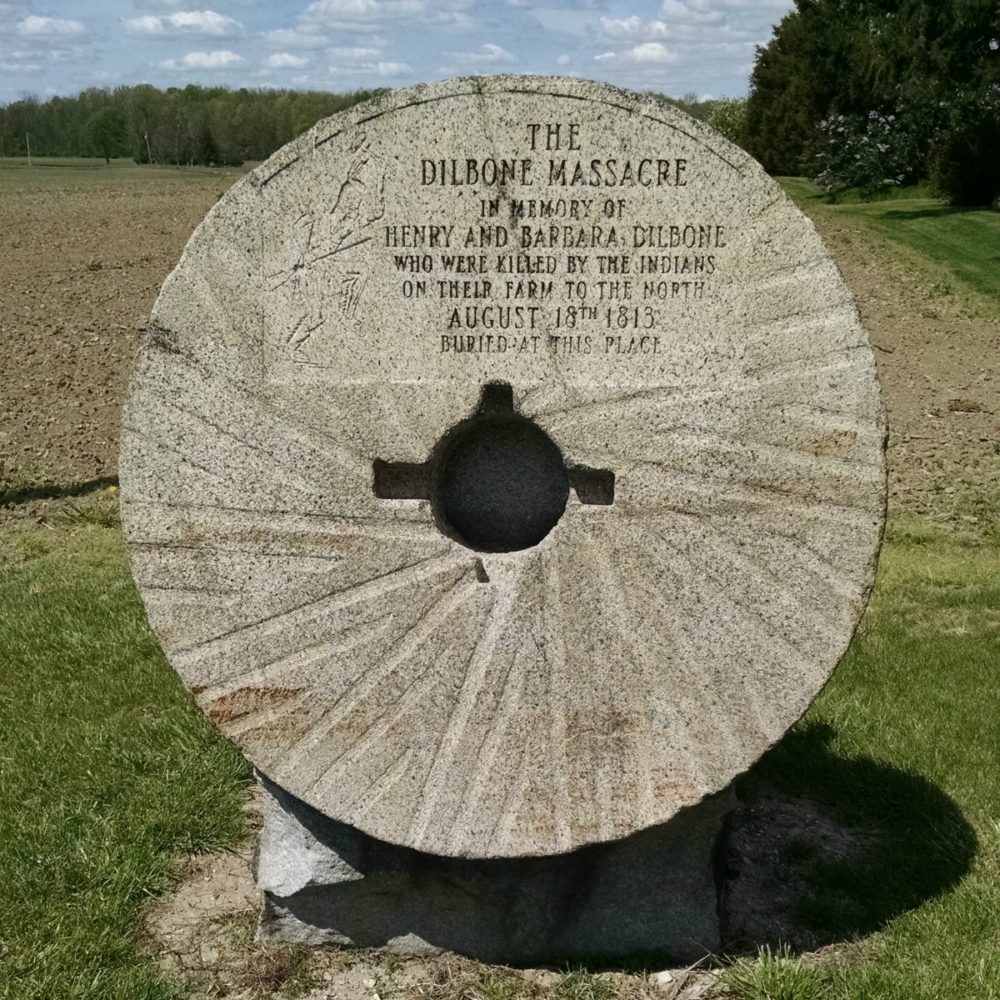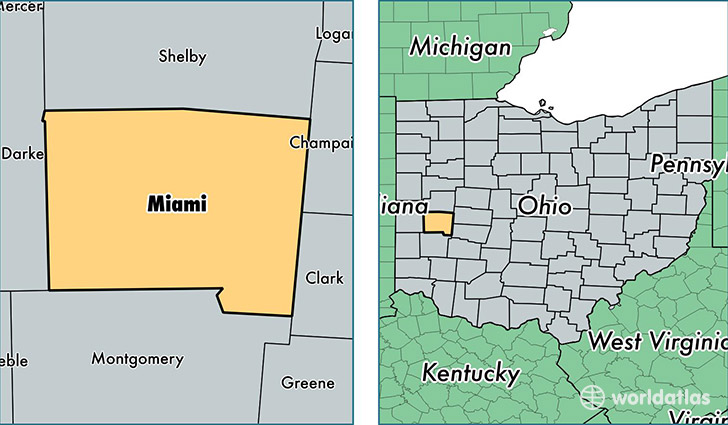
In the small clearing of a green farm field in western Ohio, there is a marker to Henry and Barbara Dilbone. To this day, surrounded by farm fields as far as the eye can see, it reminds passersby, as well as descendants like myself, of their sacrifice and its meaning for us today. The words, etched into a millstone, read:
In memory of Henry and Barbara Dilbone who were killed by the Indians on their farm to the north, August 18th, 1813, buried at this place.
Their story, though separated by time, shows only that while the aggressor may change, the truth about diversity and multiculturalism does not.
Henry Dilbone, the son of John Dilbone and Anna Maria Stahl, was born on July 3, 1786, in Bowers, Pennsylvania. Henry grew up never knowing his father. John had left when his son was less than a year old with the family’s savings after having sold the family farm on a business trip to Baltimore, and he never returned. John was later found, robbed and dead, at the age of twenty-six. Henry was German on both his paternal and maternal side. Henry’s paternal grandfather, Johann Heinrich Bohn, emigrated with his father, Peter Diehl Bohn, from the Rhineland-Pfalz region of Germany, an area where Reformed theology grew strongly. Only Johann Heinrich arrived aboard the “Loyal Judith” in 1740 to Philadelphia, Pennsylvania, as his father Peter had passed away during the voyage. Henry’s maternal ancestry stemmed from Bavaria-Wurttemberg.
Henry married Barbara Millhouse, whose family was of Swiss ancestry. Their story is the story of many Americans who trace all or some of their ancestral roots to the American nation known as the “Midlands”. William Penn’s colony started out as an English endeavor for those of the Quaker faith, but was open to all of Europe regardless of ethnicity or religious creed. Penn’s dream of creating a multi-ethnic Christian utopia was so successful that the Quakers quickly became a minority in their own colony. Thousands of Germans and Swiss of various Protestant denominations made their way to America through Pennsylvania. They quickly gained a reputation for orderliness, industriousness, and thrift. The next group of settlers to take Pennsylvania up on their offer were the people of the English and Scottish border and their descendants in Northern Ireland. Commonly referred to as Scots-Irish, they quickly moved on to the outskirts of the colony for a more independent way of living, and eventually poured south into the mountainous woodlands of Appalachia.
Henry’s dream was to one day own a homestead that he could pass onto his own family. No doubt a huge part of his motivation was the loss he and his family had endured with the death of his father. He and Barbara were part of the largely English and German migration from Pennsylvania into a central strip of the wild and beautiful Northwest Territory, recently admitted as a State in the Union, and known as Ohio, in 1803. After marrying in 1805, the newlyweds set out and built a life for themselves in Miami County near the western edge of the state. Henry lost his farm at one point to the government, but worked for others until he could buy his own farmland again. By 1813, Henry owned 180 acres of rich farmland and had four children with his wife Barbara.

location of Miami County, OH
In 1813, this area had high levels of racial diversity, with over 6,000 Indians settled near the local Indian agent. An Indian agent was an employee of the U.S. federal government who was authorized to act on its behalf in interactions with the Indians. They were also in charge of distributing annuities from the U.S. government to the various tribes. Amidst the War of 1812, tensions ran high between Americans and Indians. Many of the Indians sympathized with the British, seeing the war as a way to retake the land and all of the wealth that white settlers had created on it. Two particular “community organizers,” as they would be styled today, encouraged their fellow Indians to attack the American settlers. These two Shawnee were brothers, named Tecumseh and the Prophet. The British Empire during the war offered money for white scalps too, which only sweetened the deal. Many of the Indians were of a much more passive and friendly temperament, engaging in trade and social interactions with Americans on a regular basis. The Dilbones themselves regularly traded goods from their farm with various Indians for wild game they had killed. Henry made well-known his opinion of Tecumseh and the Prophet and their violent rhetoric, which no doubt painted a target on his back.
On August 18, 1813, Henry and his wife were working in their flax field while the children played under a tree. A local Shawnee Indian by the name of Mingo George and a younger Indian teenage companion took part in a pre-planned attack on the white farmsteads. Mingo George was an Indian who regularly traded and interacted with the settlers, and the Dilbones specifically, as he was recognized by the children. Henry’s dog began to bark at the edge of the cornfield, having discovered the two Indians. Hearing this, Henry stood up and was promptly shot in the chest. Barbara began running to her children and was overtaken and dispatched with a tomahawk. She was scalped in front of her children, and Mingo George began walking toward them when another shot rang out in the distance, causing the two Indians to flee the scene.
The shot was in fact part of the coordinated attack and was the shot that killed David Garrard, one of the Dilbones’ neighbors who was at that moment making shingles in his woods with a friend. John Dilbone, the eldest child, seeing that his father had not returned from the cornfield and that his mother was dead, led the other children back to the cabin. Neighbors came and were told what had happened. One neighbor, William McKinney, went with John to the death scene and found Barbara along with Mingo George’s dropped weapons. Henry was found clinging to life in the woods, having plugged the bullet wound in his chest with a piece of his shirt. He asked about the safety of his wife and children. He asked to see his wife, and eventually his neighbors complied. Henry died shortly thereafter. Both were hastily buried to prevent further molestation of their bodies.
Meanwhile, Mingo George and his companion fled and stopped for dinner at Robert McClure’s cabin. They were fed and sent on their way, as news of the murders had not spread yet. A party of settlers was organized to find the murderers. They ambushed Mingo George at the Miami River, shot him, and pushed his body into a quagmire much like the ancient Celts and Germanics did with their criminals. The Dilbone children were raised by neighbors, and John eventually owned almost all of his father’s original farm when he became an adult.
The lesson is simple. Diversity breeds conflict, even amongst the most well-meaning of folk. To reiterate, the Indians of the territory lived largely in peace with their European neighbors, and vice versa. Much like the black crime and Muslim terrorist attacks that now plague almost every major city across Western lands goes to show though, it hardly takes a majority of the population to be violent for diversity to be dangerous. All it takes is the anti-social, violent, or idealistic youth of one cohort to begin attacking another group, as they surely will, for a greater acceptance of said violence to spread. As Ehud Would pointed out in a recent article, he personally experienced many blacks verbalizing their approval of him being killed for voicing his opinions on black behavior. The date changes, but people do not. Our ancestors realized that for them and their posterity to live in peace, other nations, such as the Indians, could not coexist amongst them. Yet now their posterity lives under a government that actively seeks to replace them with economically self-serving (or even openly hostile) tribes and nations from all over the world.
In 1918, Henry’s and Barbara’s bones were discovered by a construction crew paving a road in Miami County. A descendant of theirs was called to the scene to verify the location of the bones belonging to the Dilbones, and in 1949, a memorial was placed at the location of their hasty burial. At the dedication, a local historian, named Leonard U. Hill, closed the ceremony with these words:
May all who view this marker be reminded that the present-day comforts of life, the ease of acquiring a living and our assurance of security were not always thus. All of our pioneering ancestors endured many great hardships and a few, as the Dilbones, made the supreme sacrifice.
Many of our American ancestors purchased this land with this sort of sacrifice and more. This land has soaked in their blood during conflict and their tears during hardship. Our duty as their posterity is not only to our own posterity and their future, but also to the legacy and sacrifice of our ancestors who have bought us the ever-disappearing comforts we have enjoyed. May God preserve us, if only for the righteousness of our forefathers who conquered and built this land.
| Tweet |
|
|
|




